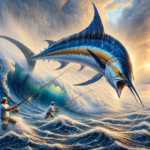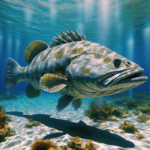Pier Fishing for Halibut in Alaska’s Coastal Waters

Introduction
Imagine standing on a pier in Alaska, the crisp air filling your lungs as you cast your line into the deep, cold waters, hoping to reel in a massive halibut. Did you know that the largest Pacific halibut ever caught weighed a staggering 459 pounds? This article will guide you through the essentials of pier fishing for halibut in Alaska’s coastal waters, covering everything from the best fishing techniques and gear to the top fishing spots and seasonal considerations.
Whether you’re a seasoned angler or a beginner, understanding the nuances of pier fishing for halibut in Alaska can significantly enhance your fishing experience. This guide aims to provide you with all the information you need to make your next fishing trip a success.
Background/Context
Historical or Cultural Significance
Halibut fishing has deep roots in Alaskan culture and history. Indigenous peoples have relied on halibut as a staple food source for centuries, using traditional methods to catch these giant flatfish. Today, halibut fishing remains a vital part of Alaska’s economy and recreational activities, attracting anglers from around the world.
Geographical Overview
Alaska’s coastal waters are a prime habitat for Pacific halibut, thanks to the nutrient-rich currents and diverse marine ecosystem. The state’s coastline stretches over 6,640 miles, offering numerous fishing spots with varying conditions. The climate is generally cold, with temperatures ranging from 30°F to 60°F, depending on the season and location.
Key Points/Details
Fishing Techniques
Technique Overview
Pier fishing for halibut involves several techniques, including bottom fishing, jigging, and using live bait. Bottom fishing is the most common method, where anglers use heavy weights to keep the bait near the ocean floor, where halibut are typically found.
When and Where to Use
Bottom fishing is most effective during high tide when halibut are more likely to be feeding near the shore. Jigging can be used in deeper waters, especially around structures like piers and docks. Live bait, such as herring or squid, is particularly effective during the summer months when halibut are more active.
Recommended Gear
- Rods: Heavy-duty rods, around 6-7 feet long, are ideal for handling large halibut.
- Reels: High-capacity, saltwater spinning reels with strong drag systems.
- Lines: Braided lines with a test strength of at least 50 pounds.
- Bait: Live bait like herring, squid, or artificial lures designed to mimic these prey.
Species Information
Species Overview
Pacific halibut are large, flatfish known for their size and strength. They prefer cold, deep waters and are usually found near the ocean floor. Halibut are opportunistic feeders, preying on smaller fish, crustaceans, and squid.
Best Practices
To successfully catch halibut, use heavy-duty gear and ensure your bait is near the ocean floor. Patience is key, as halibut can be elusive. Pay attention to tidal movements and fish during high tide for the best results.
Location Information
Top Fishing Spots
- Seward: Known for its accessible piers and abundant halibut population.
- Homer: Often referred to as the “Halibut Fishing Capital of the World.”
- Valdez: Offers excellent pier fishing opportunities with stunning scenic views.
Regulations and Licenses
Before fishing, ensure you have the necessary licenses and are aware of local regulations. In Alaska, a sport fishing license is required, and there are specific catch limits and size restrictions for halibut. Always check the latest regulations from the Alaska Department of Fish and Game.
Seasonal Considerations
Seasonal Variations
Halibut fishing in Alaska is best from May to September, when the fish are more active and closer to shore. During the winter months, halibut tend to move to deeper waters, making them harder to catch from piers.
Best Times to Fish
The optimal time for pier fishing is during high tide, particularly in the early morning or late evening. These times coincide with the halibut’s feeding schedule, increasing your chances of a successful catch.
Events and Tournaments
Event Overview
Alaska hosts several halibut fishing tournaments, such as the Homer Jackpot Halibut Derby, which runs from May to September. These events offer cash prizes and are a great way to test your skills against other anglers.
Preparation Tips
To prepare for a tournament, practice your fishing techniques, ensure your gear is in top condition, and familiarize yourself with the tournament rules. Arrive early to secure a good fishing spot and bring plenty of bait.
Tips and Best Practices
General Tips
- Always check the weather forecast before heading out.
- Use fresh bait for better results.
- Be patient and persistent; halibut fishing can require long hours.
Avoid Common Mistakes
- Not using enough weight to keep the bait near the ocean floor.
- Fishing during low tide when halibut are less active.
- Ignoring local regulations and catch limits.
Advanced Techniques
- Try using a fish finder to locate halibut more effectively.
- Experiment with different bait types and sizes to see what works best.
- Use a chum bag to attract halibut to your fishing area.
Gear and Equipment Recommendations
Essential Gear
- Heavy-duty fishing rod and reel
- Braided fishing line (50-pound test)
- Live bait or artificial lures
- Weights and sinkers
- Fishing license
Optional Gear/Upgrades
- Fish finder
- Chum bag
- Fishing gloves
- Portable cooler for storing your catch
Where to Buy or Rent
Local fishing shops in Alaska, such as The Fish House in Seward or Homer Fishing Hole, offer a wide range of gear for purchase or rent. Online stores like Bass Pro Shops and Cabela’s also provide quality fishing equipment.
Safety and Conservation
Safety Tips
- Always wear a life jacket when fishing from a pier.
- Be aware of weather conditions and avoid fishing during storms.
- Keep a first aid kit handy for emergencies.
Conservation Practices
- Practice catch and release to help maintain halibut populations.
- Respect local wildlife and avoid disturbing their habitats.
- Follow all fishing regulations and catch limits.
Planning Your Trip
Accommodations
There are numerous lodging options near popular fishing spots. In Seward, consider staying at the Seward Windsong Lodge. In Homer, the Land’s End Resort offers comfortable accommodations with easy access to fishing piers.
Travel Tips
Alaska is accessible by air, with major airports in Anchorage and Fairbanks. From there, you can rent a car or take a shuttle to your fishing destination. Plan your route in advance and consider the weather conditions when traveling.
Additional Activities
Alaska offers a range of activities for non-fishing time, including hiking, wildlife viewing, and exploring local museums. The Alaska SeaLife Center in Seward and the Pratt Museum in Homer are worth a visit.
Frequently Asked Questions (FAQs)
What is the best time of year for halibut fishing in Alaska?
The best time for halibut fishing in Alaska is from May to September.
Do I need a fishing license to fish for halibut in Alaska?
Yes, a sport fishing license is required to fish for halibut in Alaska.
What type of bait is best for halibut fishing?
Live bait such as herring or squid is highly effective for halibut fishing.
Are there any size or catch limits for halibut in Alaska?
Yes, there are specific size and catch limits for halibut. Check the latest regulations from the Alaska Department of Fish and Game.
Conclusion
Pier fishing for halibut in Alaska’s coastal waters offers an exciting and rewarding experience for anglers of all skill levels. By understanding the best techniques, gear, and locations, you can increase your chances of a successful catch. Remember to follow local regulations and practice sustainable fishing to help preserve this valuable resource for future generations. So grab your gear, head to Alaska, and enjoy the thrill of halibut fishing!




